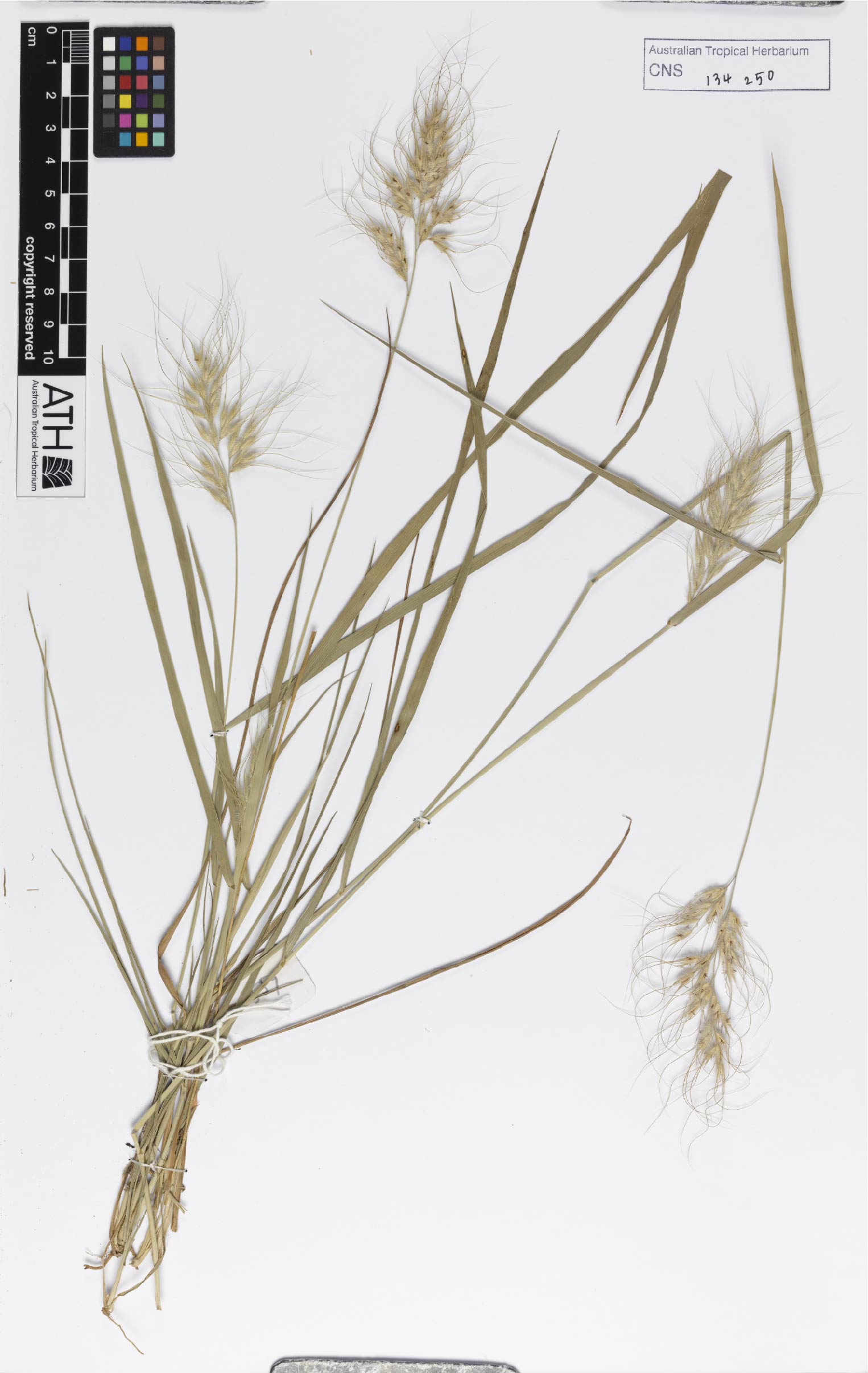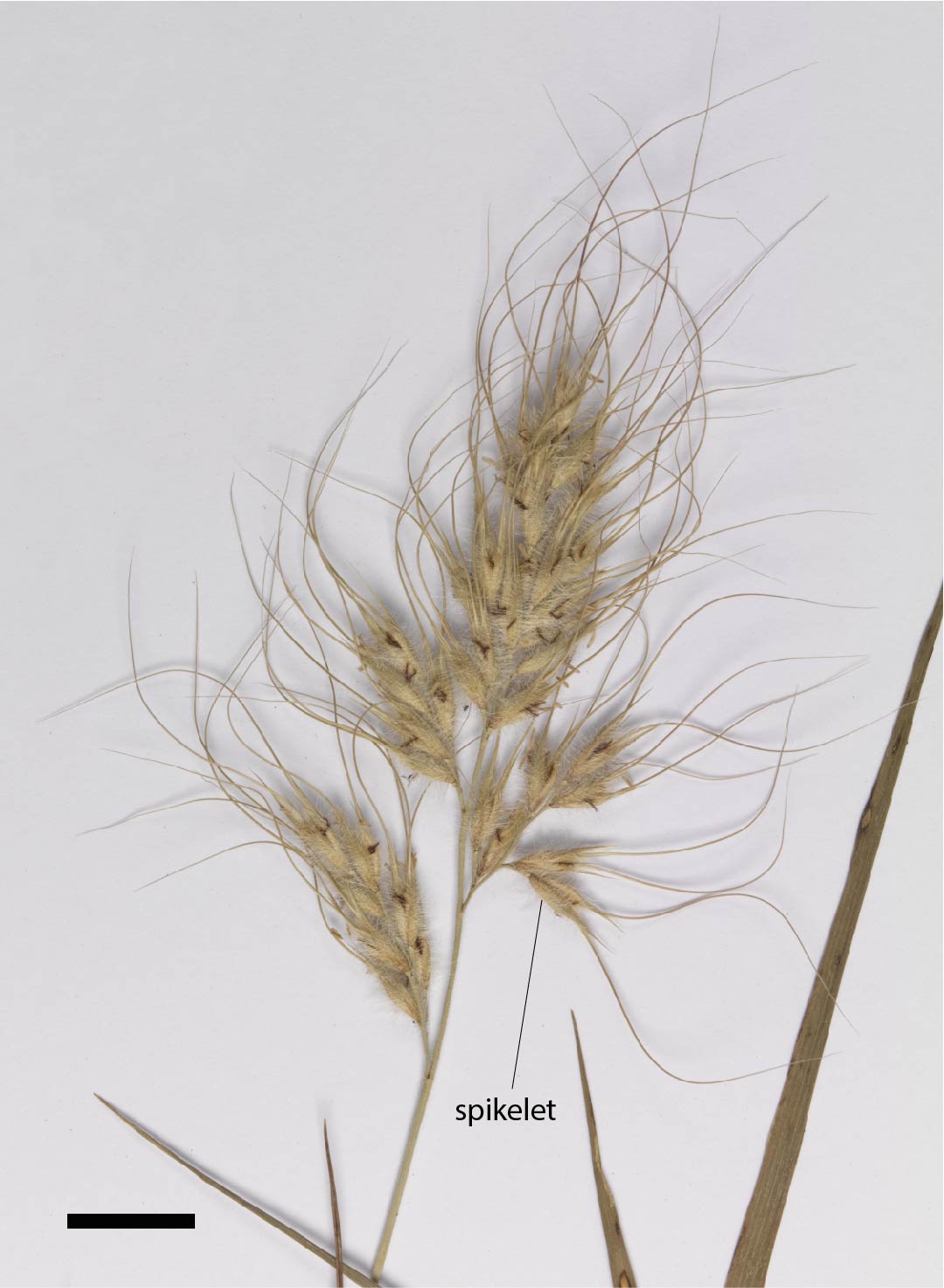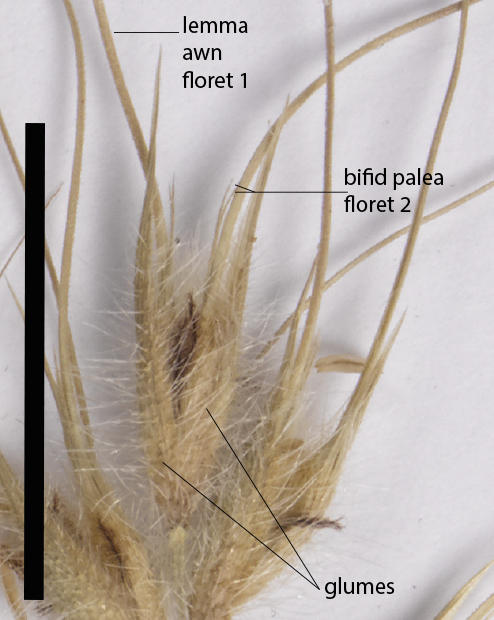Eriachne squarrosa
R.Br.
This species occurs in Cape York Peninsula as an erect perennial, 38-90 cm high. Leaves and stems with warty based hairs or are hairless. Leaves are cauline (arising along the stem) with blades to 17-30 cm long (Fig. 1). Inflorescences or flowering branches terminate the stem and are exserted some distance from leaf axils. The inflorescences or flowering branches are dense panicles with branches arising along a central stem, panicles are c. 3 cm long, c. 1.5 cm wide (Fig. 2). Eriachne squarrosa has spikelets (the basic flowering unit) consisting of two glumes encompassing two bisexual florets (modified flowers) (Fig. 3). The florets are shorter than the glumes, with the lemma of each floret giving rise to a curved awn c. 25 mm long, the palea of each floret is split into two small awns 1-5 mm long.
Botanical Description
An annual or perennial species to 90 cm high. The culms or stems hairy with tubercle-based hairs or glabrous. Leaves hairy with tubercle-based hairs or glabrous; leaf blade to 17-30 cm long and up to 3 mm wide. The inflorescences are dense panicles, c. 3 cm long, c. 1.5 cm wide (Fig. 2). Spikelets are defined by two glumes 9-11 mm long, each with a long drawn out apex or beak almost the same length as main body. The glumes encompass two bisexual florets, the florets are much shorter than the glumes (2.5-6 mm long). The lemma of each floret is awned, the lemma awn c. 25 mm long, with the palea of each floret splitting to form two awns much shorter than the lemma awn, 1-5 mm long (Fig. 3). The lemma is densely hairy with hairs exceeding the apex, is abruptly contracted at the awn junction and has no grooves along the lemma apex but has two shallow apical depressions.
Diagnostic Features
Eriachne squarrosa is one of many species of Eriachne characterised by long awned spikelets, the awns curled, curved or bent. Other long awned species of Eriachne which occur in the region and may be easily confused with this species are E. armittii, E. burkittii, E. glauca, E. stipacea, E. vesiculosa and E. rara. Some of these species are more easily distinguished than others. Most are treated in this guide, however some of the key differences between the species are shown in Table 1. In other regions of Australia eg. the Northern Territory, additional species may also need to be considered. Eriachne squarrosa is distinguished by the combination of the following characters, a perennial habit, the absence of bladder like sacs on the upper leaf surface, a dense hairy inflorescence, the glume elongated into a long thin tip or beak, the florets being distinctly shorter than the glumes and the bifid two awned palea. Users are encouraged to consult Lazarides (2005) or Simon & Alfonso (2011) for more detail on distinguishing between these species.
Natural Values
This species is likely to provide seed for granivorous or seed eating animals.
Habitat
This species occurs along eastern Queensland from Townsville to Cape York Peninsula. In the Northern Territory it is only known from a coastal locality in the north east; also known from Malesia. Often found in moist, low-lying, sandy flats and depressions under Melaleuca spp. and on floodbanks of seasonal streams; also recorded from sandy granite ridges (Lazarides 2005, Simon 2011).
Land Management Notes
Species of this genus are considered generally to be of low forage value (Lazarides 2002).



Resources
AVH (2017) Australia’s Virtual Herbarium, Council of Heads of Australasian Herbaria, <http://avh.chah.org.au>, accessed 30 May 2017.
Lazarides, M. (1995) The genus Eriachne (Eriachneae, Poaceae). Australian Systematic Botany 8(3): 355-452.
Lazarides, M. (2002) Economic attributes of Australian grasses. Flora of Australia 43: 213-245.
Lazarides, M., Weiller, C.M. & McCusker, A. in Mallett, K. (ed.) (2005) Eriachne. Flora of Australia 44B: 132-175.
Simon, B.K. & Alfonso, Y. (2011) AusGrass2, http://ausgrass2.myspecies.info/accessed on [20 March 2017].

